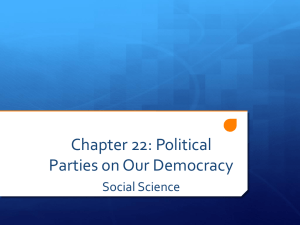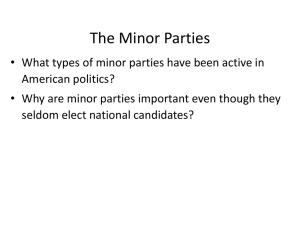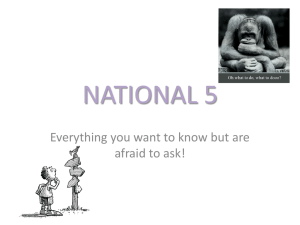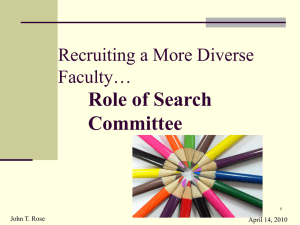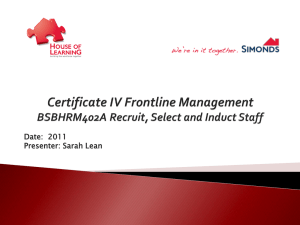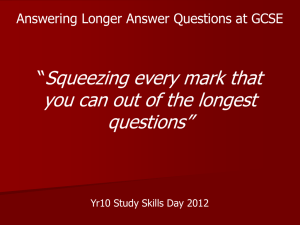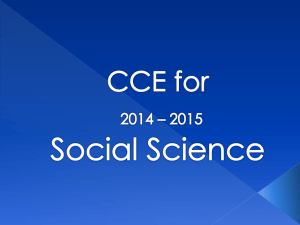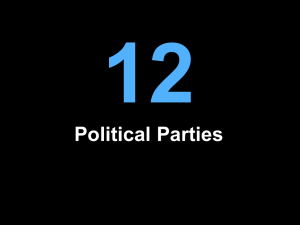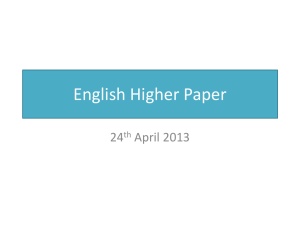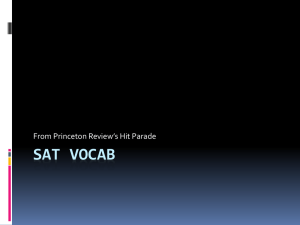Cambridge Activities
advertisement
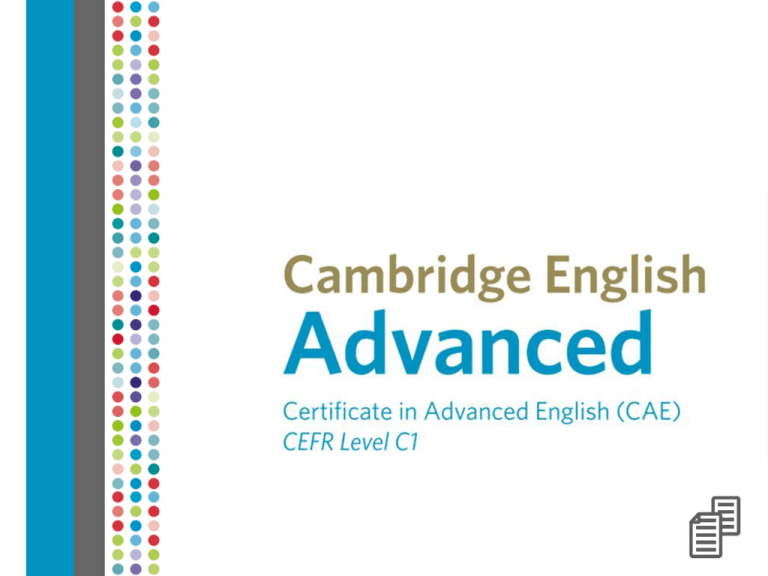
Paper Content Reading (1 h 15’) 4 parts/34 questions Writing (1 h 30’) Speaking (15’ per pair of candidates) 20% 20% 2 parts Use of English 5 parts/50 questions (1 hour) Listening (about 40’) Marks (% of total) Shows you can deal confidently with different types of text, such as fiction, newspapers and magazines. You create two different pieces of writing, such as articles, essays, letters, proposals, reports and reviews. 20% Tests your use of English with different types of exercise that show how well you can control your grammar and vocabulary. 20% Tests your ability to follow and understand a range of spoken materials, such as interviews, radio broadcasts, presentations, talks and everyday conversations. 4 parts/30 questions 20% 4 parts Purpose Tests your ability to communicate effectively in face-to-face situations. You will take the Speaking test with another candidate. What I wear to work Gayle Mellor (31), Modern Languages teacher We don’t have a dress code as such. The male the younger one giggle about it, which is harmless teachers wear ties, but there is a really diverse enough. Then you occasionally eavesdrop on the approach to smart style amongst the female staff. older girls doing a hard-hitting TV-style commentary Respect comes from body language and behaviour on what the staff are wearing, which can be ratherthantheclothesyouwear,butofcoursecertain unnerving. But the popular stereotype of teachers things would be deemed inappropriate, and I’ve got wearing hard-wearing materials like corduroy only noproblemwiththat.It’s not mychoiceofoutfitthat makesmelaugh,becauseIloveit!Sometimes,ifolder puts me in the mood for work, because I wear my pupils like something you wear, they’ll ask where it’s work clothes socially as well, but when I pick up my from,whichcancontributetobreakingdownbarriers. bigsatchel,Icanfeelmyselfgoinginto‘teachermode’ If you asked my colleagues, they’d say sky blue skirts becauseit’s gotallmystuffinit. have become a bit of a signature for me. Not that I What you wear as a teacher does impact on your mind,becausemywardrobeisbuiltaroundstylesand relationshipwiththepupilsthough,especiallythegirls. coloursthatIfeelmostcomfortablein,andIwouldn’t changethat. Ifwewearjeansonnon-teachingdays, 1 What point does Gayle make about the clothes she wears for teaching? A They should put her in the right frame of mid for work. B She needs to dress smartly if she is to keep her pupils’ respect. C Following fashion helps her to understand her pupils’ attitudes better. D There are limits to the range of clothes that she considers suitable. 2 Gayle sometimes feels slightly uncomfortable when A people can tell she is a teacher from her clothes. B younger pupils find her clothes amusing keep her pupils’ respect. C pupils criticise their teachers’ clothes. D people associate her with one particular style of clothes. 7 G 8 E You are going to read a newspaper article. For questions 13-19, choose the answer (A, B, C or D) which you think fits best according to the text. Mark your answers on a separate answer sheet. BRIDGES The Bosphorus Bridge in Istanbul links Europe to Asia. If you are standing in the middle of it, then what continent are you in? No, it’s not a brainteaser with a quick answer; it’s a question which hints at the fact that bridges are more complicated things than mere ways of getting from A to B. Dr lain Borden researches psychological aspects of architecture at London University. ‘Unlike going through a doorway, crossing a bridge takes time. While you are corssing the bridge, you are in neither one place nor the other but in a strange kind of limbo state,’ he explains. It may sound a little far-fetched, but Dr Borden’s view is tapping into our fundamental responses to the physical world around us. The Ancient Britons attached great spiritual significance to rivers and certainly appreciated this concept of limbo. Recently a team from the Museum of London excavated the remains of the oldest bridge found so far in Britain (about 3,500 years old), in central London. In those days the River Thames was merely a collection of shallow channels and small islands. These islands had enormous spiritual resonance as places separated from shores and connected to the river. But it is still true today that bridges are more than utilitarian structures and have a great symbolic impact. 13 What point is the writer making in the first paragraph? A Bridges have a significance beyond their basic physical function. B The impact of a bridge varies from county to country. C The popular view of what bridges represent has changed. D People have different reactions when crossing a bridge. You are going to read a magazine article about the rock band Franz Ferdinand and its website. For questions 20-34, choose from the sections (A-E). The sections may be chosen more than once. Which section mentions the following? positive reviews of the band’s musical output 21 A The shortcomings of some websites featuring other bands 22 B A B Inearly2004,therockgroupFranzFerdinandgottheirfirst bigbreakwhentheirsecondsingle‘TakeMeOut’reached theBritishTop10.Ayearlater,theywerecollectingawards for the best rock act and the best British band, having gained both critical and popular acclaim for their debut album, and set up their own website. Indeed, Franz Ferdinandandtheirmanagementattributedtheirsuccess to more than sharp haircuts, natty outfits and the songs themselves. They believe that while their success was in part due to the tired-and-tested marketing techniques thatmakeanewband–touringthemusicvenues,relying on the build-up of business by word-of-mouth and convincingradiostationstoplaytheirstuff–itwasalsodue innosmallparttotheinternet. Eversincethewebbecameamass-marketphenomenonin the late 1990s, record labels had largely been using it as just another marketing tool. For their biggest acts, they would build hugely expensive sites that acted as little more than moving billboards, leaving everything else to fan sites. Franz Ferdinandweredifferent.Theywereamongstanewwaveof popular bands who used the medium to bridge the gap between themselves and their fans. Groups like Radiohead started the trend, allowing internet users to watch them in the studio and share their innermost thoughts via online diaries. Franz Ferdinand took things a step further. They regularly appeared on their own message boards, chatting indiscriminately to fans and posting diary entries and photos fromwherevertheywereintheworld,usingtheirowndigital cameras,microphonesandlaptops.Allfourgroupmembers had access to the site’s content-management system, makingiteasyforthemtoupdateitthemselves. Paper 2 WRITING (1 hour 20 minutes) Part 1 For questions 1-12, read the text below and decide which answer (A, B, C or D) best fits each gap. There is an example at the beginning (0). For questions 13-27, read the text below and think of the word which best fits each gap. Use only one word in each gap. There is an example at the beginning. (13) Unlike (14) Which (15) From (16) To (17) due/owing/thanks (18) unless/before/until For questions 28-37, read the text below. Use the word given in capitals at the end of some of the lines to form a word that fits in the gap in the same line. There is an example at the beginning (0). (28) ACCESSIBLE (29) PASSIONATELY For questions 38-42, think of one word only which can be used appropriately in all three sentences. Here is an example (0). covered covered covered false false false (38) COVERED (39) FALSE For questions 43-50, complete the second sentences so that it has a similar meaning to the first sentence, using the word given. Do not change the word given. You must use between three and six words, including the word given. Here’s an example (0) failed to realize the importance is believed to have been You will hear three different extracts. For questions 1 ─ 6, choose the answer (A, B or C) which fits best according to what you hear. There are two questions for each extract. You hear two people on a music programme talking about the singer Nancy Graham. 1 What is the man’s opinion of Nancy’s second album? A He thinks it is very experimental. B He appreciates the continuity of style. C He wonders if she is lacking inspiration. 2 What do the two speakers agree about? A the freshness of the music B the lack of real emotion in the music C the calming effect of the music on the listener You will hear a marine wildlife photographer called Bruce Hind talking about his work. For questions 7 ─ 14, complete the sentences. MARINE WILDLIFE PHOTOGRAPHER Bruce says that aspect of his work. PLANNING Before going on a trip, Bruce makes the photographs he hopes to take. 7 is the most important DRAWINGS 8 of You will hear part of a radio interview in which the comedian and writer Jane Clarkson is talking about her work. For questions 15 ─ 20, choose the answer (A, B, C or D) which fits best according to what you hear. 15 What did Jane find difficult about writing a book? A She couldn’t travel around the country. B She didn’t get any instant reaction to her work. C She had to spend time looking after her daughter. D She found the process itself very challenging. 16 What do the two speakers agree about? A They didn’t think the book was funny. B They were dismissive of her initial success. C They thought her male colleagues were better writers. D They thought she should stick to being a comedian. You will hear five short extracts in which people are talking about keeping fit. TASK ONE TASK TWO For questions 21 ─ 25, choose from the list (A ─ H) the person who is speaking. For questions 26 ─ 30, choose from the list (A ─ H) what each speaker is expressing. While you listen you must complete both tasks. A an artist B a fitness instructor C a sales manager Speaker 1 B 21 Speaker 2 G 22 Speaker 3 C 23 Speaker 4 A 24 Speaker 5 E 25 D a childminder E a doctor F an office cleaner G a secretary H a retired person A a pride in personal achievements B indifference to current trends C an enjoyment of a daily routine D a commitment to taking regular exercise E a desire to improve his or her diet F awareness of his or her health problems G a reluctance to admit failure H resentment of another person’s attitude Speaker 1 C 26 Speaker 2 H 27 Speaker 3 F Speaker 4 D 29 Speaker 5 B 30 28 The examiner asks questions and you may have to give information about your interests, studies, careers, etc. Examples of questions in Part 1: • What is the one thing you own that you couldn’t live without? (Why?) • How important is it to share the same musical tastes as your friends? (Why?/ Why not?) • What do you think you’ll be doing in five years’ time? Candidate A: • What difficulties might the photographers be having? • Who might be interested in the photographs they are taking? Question for Candidate B: • Which of the photographs being taken would be the most interesting? Candidate B • How might the people be feeling? • What might have caused them to be feeling like this? Question for Candidate A: • Which picture shows the strongest emotion? • What hopes and fears for the future might each chapter include? • Which chapter might interest readers most? A discussion on topics related to Part 3, e.g.: • Are television programmes more effective then books in dealing with topics like our hopes and fears for the future? (Why? Why not?) • Is it important for parents to read to their children? (Why? Why not?) Slide 2 Useful links: http://www.cambridgeenglish.org/exams-and-qualifications/advanced/ https://www.teachers.cambridgeesol.org/ts/exams/generalenglish/advanced/a dviceforteachers http://www.flo-joe.co.uk/cae/students/index.htm Slide 4 - The Reading paper (worth 20% of the total marks for the exam) contains 4 parts. Part 1 Content Task focus Candidates are expected to show Three texts on one theme understanding of attitude, detail, from a range of sources. implication, main idea, opinion, purpose, Each text has two specific information, text organisation multiple-choice questions. features, tone and text structure. Slide 5 - The Reading paper (worth 20% of the total marks for the exam) contains 4 parts. Part Content Task focus 2 A text from which six paragraphs have been removed and placed in a jumbled order, together with an additional paragraph, after the text. Candidates are expected to show understanding of attitude, detail, implication, main idea, opinion, purpose, specific information, text organisation features, tone and text structure. Slide 6 - The Reading paper (worth 20% of the total marks for the exam) contains 4 parts. Part 3 Content Task focus A text followed by seven multiple-choice questions. Candidates are expected to show understanding of attitude, detail, implication, main idea, opinion, purpose, specific information, text organisation features, tone and text structure. Slide 7 - The Reading paper (worth 20% of the total marks for the exam) contains 4 parts. Part 4 Content Task focus A text or several short texts preceded by 15 multiplechoice questions. Candidates are expected to show understanding of attitude, detail, implication, main idea, opinion, purpose, specific information, text organisation features, tone and text structure. Slide 9 - The Writing paper (worth 20% of the total marks for the exam) contains 2 parts. Part 1 Content Task focus Candidates are expected to be able to write nonspecialised text types such as an article, a contribution One to a longer piece, an essay, information sheets, a letter, a compulsory proposal, a report, a review, or a competition entry, with question. a focus on advising, comparing, evaluating, expressing opinions, hypothesizing, justifying and persuading. Slide 13 - The Writing paper (worth 20% of the total marks for the exam) contains 2 parts. Part 2 Content Task focus Candidates are expected to be able to write nonCandidates choose specialised text types such as an article, a one task from a contribution to a longer piece, an essay, choice of five information sheets, a letter, a proposal, a report, questions a review, or a competition entry, with a focus on (including the set advising, comparing, evaluating, expressing question options). opinions, hypothesizing, justifying and persuading. Slide 14 - If candidates have read one of the set books and want to write about it, they may decide to try Question 5. You have a choice of two tasks, 5(a) or 5(b), for this question. Slide 16 - The Use of English paper (worth 20% of the total marks for the exam) contains 5 parts. Part Content Task focus 1 A modified cloze test containing twelve gaps and followed by twelve multiple-choice questions. Candidates are expected to demonstrate the ability to apply their knowledge of the language system. Slide 17 - The Use of English paper (worth 20% of the total marks for the exam) contains 5 parts. Part 2 Content Task focus A modified open cloze test containing fifteen gaps. Candidates are expected to demonstrate the ability to apply their knowledge of the language system. Slide 18 - The Use of English paper (worth 20% of the total marks for the exam) contains 5 parts. Part 3 Content Task focus A text containing ten gaps. Each gap Candidates are expected to corresponds to a word. The stems of demonstrate the ability to apply the missing words are given beside their knowledge of the the text and must be changed to language system. form the missing word. Slide 19 - The Use of English paper (worth 20% of the total marks for the exam) contains 5 parts. Part 4 Content Task focus Five questions, each one containing three discrete sentences. Each Candidates are expected to sentence contains one gap, which demonstrate the ability to apply must be completed with one word their knowledge of the which is appropriate in all three language system. sentences. Slide 20 - The Use of English paper (worth 20% of the total marks for the exam) contains 5 parts. Part 5 Content Task focus Eight separate questions, each with Candidates are expected to a lead-in sentence and a gapped demonstrate the ability to apply second sentence to be completed in their knowledge of the three to six words, one of which is a language system. given ‘key-word’. Slide 22 - The Listening paper (worth 20% of the total marks for the exam) contains 4 parts. Part 1 Content Task focus Candidates are expected to be able to show understanding of Three short extracts, from exchanges agreement , attitude, course of between interacting speakers. There action, detail, feeling, function, are two multiple-choice questions gist, interpreting context, main for each extract. points, opinion, purpose, specific information etc. Slide 23 - The Listening paper (worth 20% of the total marks for the exam) contains 4 parts. Part Content Task focus 2 A monologue with a sentence completion task which has eight items. Candidates are expected to be able to show understanding of agreement , attitude, course of action, detail, feeling, function, gist, interpreting context, main points, opinion, purpose, specific information etc Slide 24 - The Listening paper (worth 20% of the total marks for the exam) contains 4 parts. Part 3 Content Task focus Candidates are expected to be able to show A text involving understanding of agreement , attitude, interacting speakers, course of action, detail, feeling, function, with six multiple-choice gist, interpreting context, main points, questions. opinion, purpose, specific information etc Slide 25 - The Listening paper (worth 20% of the total marks for the exam) contains 4 parts. Part Content Task focus 4 Five short themed dialogues, with ten multiple-matching questions. Candidates are expected to be able to show understanding of agreement , attitude, course of action, detail, feeling, function, gist, interpreting context, main points, opinion, purpose, specific information etc Slide 27 - The Speaking paper (worth 20% of the total marks for the exam) contains 4 parts. (Two/three candidates and two examiners) Part 1 Content Task focus A conversation between General the interlocutor and each interactional and candidate social language. (spoken questions). Timing 3 min. Slide 28 - The Speaking paper (worth 20% of the total marks for the exam) contains 4 parts. Part Content Task focus Timing 2 An individual “long turn” or each candidate, with a brief response from the second candidate (visual stimuli, with spoken instructions) Organising a larger piece of discourse; comparing, describing, expressing opinions, speculating. 3 min. Rubric for Part 2: Candidate A It’s your turn first. Here are your pictures. They show photographers working in different situations. I’d like you to compare two of the pictures, and say what difficulties the photographers might be having, and who might be interested in the photographs they are taking. Candidate B Which of the photographs being taken would be the most interesting? (Why?) Slide 29 - The Speaking paper (worth 20% of the total marks for the exam) contains 4 parts. Part Content Task focus Timing 2 An individual “long turn” or each candidate, with a brief response from the second candidate (visual stimuli, with spoken instructions) Organising a larger piece of discourse; comparing, describing, expressing opinions, speculating. 3 min. Rubric for Part 2: Candidate B Now here are your pictures. They show people expressing different emotions. I’d like you to compare two of the pictures, and say how the people might be feeling, and what might have caused them to feel like this. Candidate A Which picture shows the strongest emotion? (Why? Slide 30 - The Speaking paper (worth 20% of the total marks for the exam) contains 4 parts. Part 3 Content Task focus A two-way Sustaining an interaction; conversation between exchanging ideas, expressing and the candidates (visual justifying opinions, agreeing and written stimuli, and/or disagreeing, suggesting, with spoken speculating, evaluating, reaching a instructions). decision through negotiation etc. Timing 4 min. Rubric for Part 3: Now, I’d like you to talk about something together for about three minutes. Here are some pictures illustrating the chapters of a book called ‘Hopes and Fears for the Future’. First, talk to each other about what hopes and fears for the future each chapter might include. Then decide which chapter might interest readers most. All right? Slide 31 - The Speaking paper (worth 20% of the total marks for the exam) contains 4 parts. Part 4 Content Task focus A discussion on topics Expressing and justifying opinions, related to Part 3 agreeing and/or disagreeing. (spoken questions). Timing 4 min.
